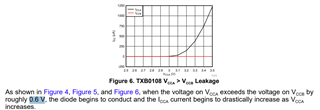Other Parts Discussed in Thread: TXU0304
Tool/software:
Hello,
In my system I need to scale down SPI signal and TXB0104 seems to be ticking a lot of boxes, including cost. The caveat here is that it needs to do it in almost back to front, than suggested by the default schematic, where the controlling side is at the higher potential. I understand the IC is auto bidirectional, however, this potentially causes an issue with OE.
The datasheet states OE is supplied by Vcca (display side) that needs to be lower than Vccb (CPU side). The guide (SCEA043) says that when not used, OE should be tied to Vcca. The latter suggests OE is an input and is not pulled high internally. This, in turn, means I could potentially simply scale down the incoming CPU signal to be at the correct level.
OE is advertised as referenced to Vcca, but, unless reading it incorrectly, the recommended operating conditions (see table below) suggest it can accept up to 5.5V.
Please note that, based on the nominal voltages, the scale down would only be by 0.5V. Taking allowed max voltage into consideration, I could potentially reduce the difference to 0.3V and still leave little margin (not great, but possible). The reason I mention that is that Biasing document (SCEA060) states the difference between Vcca and Vccb must not exceed 0.6V, which, with little margin, is met anyway (again not great, but...).

Any issues with planning to use TXB0104 'back to front'?
Can OE be used connected directly to CPU, knowing there's up to 0.5V too high?
Any issues with using scaled down OE control?
Thank you very much for help!


